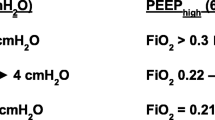Abstract
Ten newborn infants with the idiopathic respiratory distress syndrome (IRDS) or foetal aspiration (FA) were treated with a simplified nasal CPAP system (continuous positive airway pressure).
The system consists of a Hudson binasal cannula and a Benveniste pediatric jet device (weight 5 g). The desired airway pressures are obtained by adjustment of the jet flow in accordance with the naso-pharyngeal flow/pressure relationship. The system was found to be effective in the treatment of 9 of the 10 children, as demonstrated by improved blood gas values, and improved respiration; the latter was also evident in infants with pronounced apnea. In one child pneumothorax, occuring after about 24 hours of successful CPAP treatment, necessitated respirator treatment.
The system is quick and simple to use, and permits feeding, lung physiotherapy and routine nursing of the child during treatment.
Similar content being viewed by others
References
Adler, S.M., Wyszogrodski, I.: Pneumothorax as a function of gestational age; clinical and experimental studies. Pediatrics87, 771 (1975)
Ahlström, H., Jonson, B., Svenningsen, N.W.: Continuous positive airway pressure with a face chamber in early treatment of idiopathic respiratory distress syndrome. Acta pediat. scand.62, 433 (1973)
Benvieniste, D., Pedersen, J.E.P.: A valve substitute with no moving parts for artificial ventilation in newborn and small infants. Brit. J. Anaesth.40, 464 (1968)
Bossi, E.: Spontanatmung mit kontinuerlichem endexpiratorischem Druck mittels doppelseitiger Nasenkanüle beim Neugeborenen. Mschr. Kinderheilk.123, 141 (1975)
Brendstrup, A., Kamper, J.: Kontinuerligt luftvejsovertryk (CPAP) hos nyfødte ved hjælp af binasalt kateter og gasdyse. Lecture in Dansk pædiatrisk Selskab (1977)
Chernick, V., Vidyasagar, D.: Continuous negative chest wall pressure for HMD. Pediatrics49, 753 (1972)
Cohen, D., cochran, W., Griscom, N.T., Harris, G.B.C.: Naturally occuring pneumothorax in hyaline membrane disease. Pediat. Res.7, 400 (1973)
Fanaroff, A.A., Cha, C.C., Sosa, R., Crumrine, R.S., Klaus, M.H.: Controlled trial of continuous negative external pressure in the treatment of severe respiratory distress syndrome. J. Pediat.82, 921 (1973)
Fenner, A., von Stockhausen, H.B.: Konstanter positiver transpulmonaler Druck bei Patienten mit Atemnotsyndrom während Spontanatmung. Z. Geburtsh. Perinat.177, 215 (1973)
Gregory, G.A., Kitterman, J.A., Phibbs, R.H., Tooley, W.H., Hamilton, W.K.: Treatment of the idiopathic respiratory distress syndrome with continuous positive airway pressure. N. Engl. J. Med.284, 1333 (1971)
Hall, R.T., Rhodes, Ph.G.: Pneumothorax and pneumomediastinum in infants with idiopathic respiratory distress syndrome receiving continuous positive airway pressure. Pediatrics55, 4 (1975)
Kattwinkel, J.: A device for administration of continuous positive airway pressure by the nasal ronte. Pediatrics52, 131 (1973)
Mockrin, L.D., Bancalari, E.H.: Early versug delayed initiation of continuous negative pressure in infants with hyaline membrane disease. Pediatrics87, 596 (1975)
Rhodes, P.G., Hall, R.T.: Continuous positive airway pressure delivered by face mask in infants with the idiopathic respiratory distress syndrome. A controlled study. Pediatrics52, 17 (1973)
Risemberg, H.M., Fomufod, A., Hazelbake, N., Nishida, H., Peralta, M.J.: Assisted ventilation with nasal continuous positive airway pressure and its effects on morbidity and mortality in RDS. Johns Hopkins Med. J.135, 171 (1974)
Schmid, E.R., Dangel, P.H.: The use of nasal CPAP in newborns with respiratory distress syndrome. Europ. J. Intens. Care Med.2, 125 (1976)
Silverman, W.A., Andersen, D.H.: A controlled clinical trial of effects of water mist on obstructive respiratory signs, death rate and necropsy findings among premature infants. Pediatrics17, 1 (1956)
Speidel, B.D., Dunn, P.M.: Use of nasal continuous positive airway pressure to treat severe Recurrent apnea in very preterm infants. Lancet, 1976II, 658
Theilade, D.: Nasal CPAP employing a jet device for creating positive pressure. Intens. Care Med.4, 145 (1978)
Theilade, D.: Nasal continuous positive airway pressure in the treatment of whooping cough. In print
Author information
Authors and Affiliations
Rights and permissions
About this article
Cite this article
Theilade, D. Nasal CPAP treatment of the respiratory distress syndrome. Intensive Care Med 4, 149–153 (1978). https://doi.org/10.1007/BF01700257
Issue Date:
DOI: https://doi.org/10.1007/BF01700257




